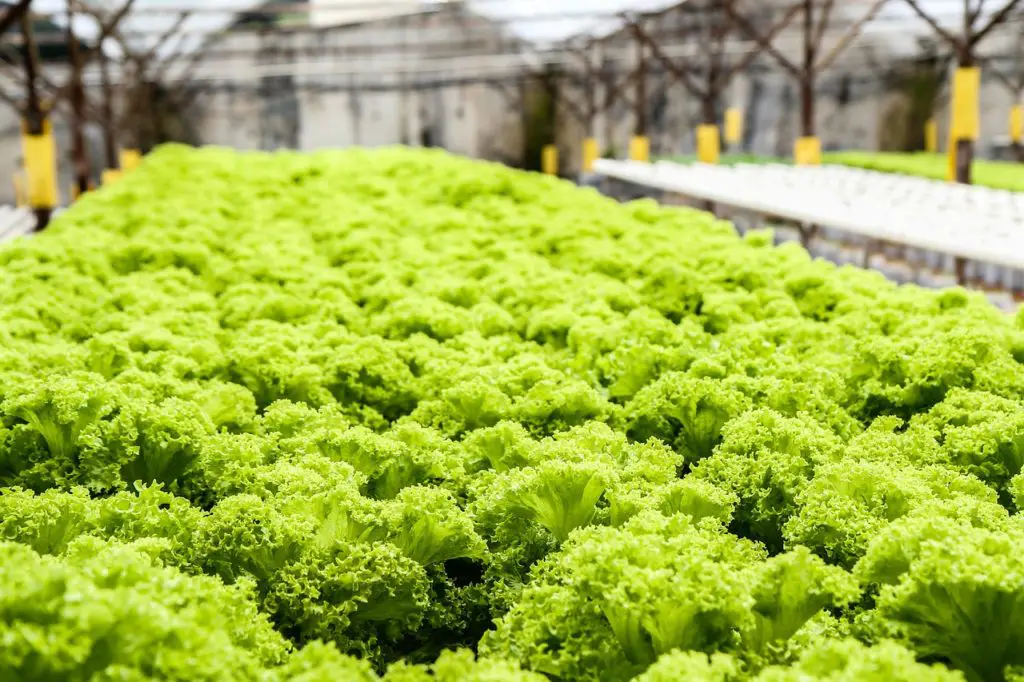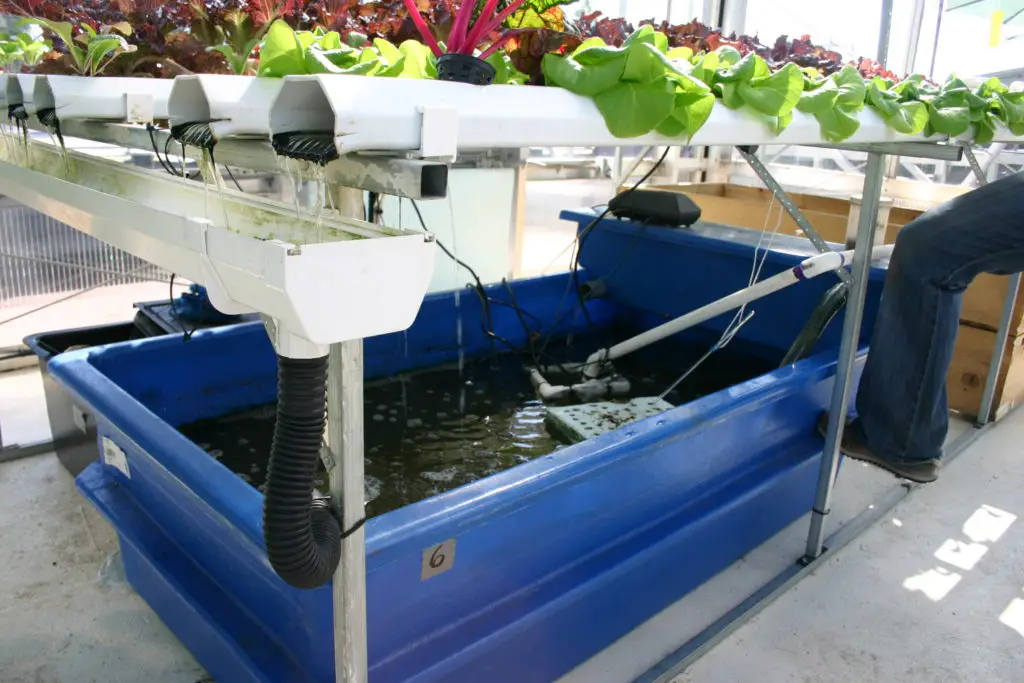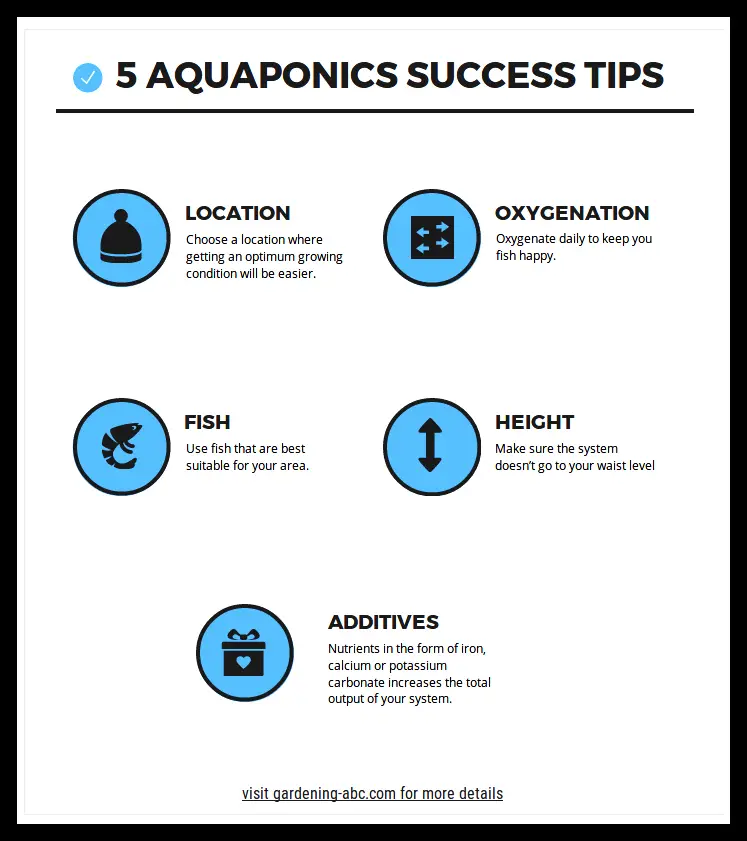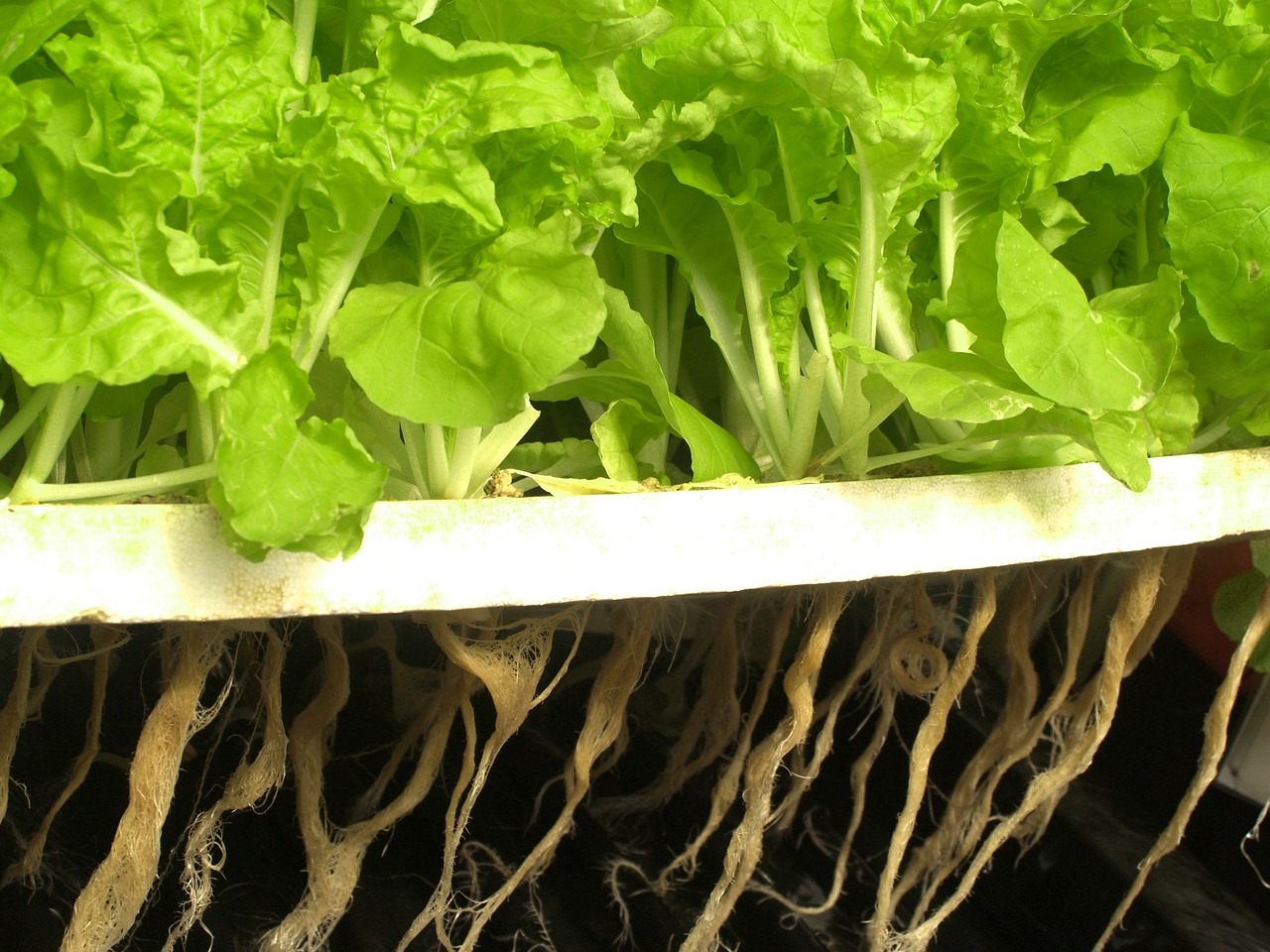We use affiliate links to run our site. When you buy through links on our site, we may earn an affiliate commission, without any added cost to you. Learn more
So, you want to set up an Aquaponics system? Don’t worry though it sounds complicated it is really an easy job. If you have some basic knowledge about the system you are ready to go.
I believe you have a basic knowledge of the system like what it is. And, what are the benefits of aquaponics? (If you have any doubt check my earlier article on the basics of an aquaponics system).
However, there is some important point which might still interest you. Let me mention five such things which will help you attain some fantastic results.
Tips For Aquaponics Success
Starting and maintaining an aquaponics system can be challenging but when you follow these 5 simple tips your success rates will increase dramatically.
1. Choose Proper Location For Your Aquaponics System:

The place has a crucial impact on the success or the failure of your aquaponics system. It is highly important for plants and fish to grow.
So, what exactly makes a suitable location for your aquaponics system? Well, there are a few things to consider. First and foremost, your system should have access to natural light.
Plants need light to photosynthesize and grow, so it’s crucial that your aquaponics system is in a location that receives at least six hours of direct sunlight per day.
This will help your plants grow big and strong, and in turn, provide your fish with the best environment to live in.
Temperature and humidity are also important factors to keep in mind when choosing a location for your aquaponics system. The ideal temperature range for your system is between 68-86°F (20-30°C).
This temperature range is optimal for the growth of both fish and plants. Temperatures that are too low can slow down the growth rate of your fish and plants, while temperatures that are too high can lead to oxygen depletion and other issues that can harm your fish.
Also, keep an eye on humidity levels. Your system should be kept in a stable environment with relative humidity levels between 50-70%. This range is perfect for the growth of your plants and fish, and it can help prevent the development of mold or other unwanted issues.
Make sure no chemicals or other harmful substances are present in the water. It can kill both your plants and fish.
Protect your aquaponics system from extreme weather conditions. For example, if you live in an area that experiences harsh winters or frequent storms, you’ll need to ensure that your system is protected from the elements.
This may mean building a greenhouse or providing some other form of protection to shield your system from the weather.
2. Regularly Oxygenate The Water In Aquaponics Fish Tank:
Oxygenation is essential for the fish. A lack of oxygen can make your whole system fall apart. Without enough oxygen, fish become stressed, develop diseases, or even die. So, how can you ensure that your fish have the oxygen they need to thrive?
Firstly, please understand, oxygen is not just important for your fish but also for the beneficial bacteria in your system that are responsible for the nitrogen cycle. These bacteria help to break down the waste produced by your fish and convert it into nutrients that your plants can use.
Without enough oxygen, these bacteria won’t be able to do their job properly, which can lead to imbalances in your system.
So, what can you do to ensure that your fish and bacteria get enough oxygen? One option is to use an air pump. An air pump works by forcing air into your fish tank, creating bubbles, and agitating the water. This process helps to increase the oxygen levels in the water, ensuring that your fish and bacteria stay healthy.
Another option is to use an airstone. An airstone is a small device that releases air into the water, creating tiny bubbles. These bubbles help to distribute oxygen throughout the water, making it available to your fish and bacteria. Airstones can be a great addition to your system, especially if you have a large fish tank or a lot of fish.
When choosing an air pump or airstone, it’s important to consider the size of your tank. You’ll need to choose a device that is powerful enough to oxygenate the entire volume of water in your tank. If you’re not sure what size air pump or airstone to choose, speak to a professional or do some research online to find the right one for your system.
In addition to using an air pump or airstone, there are a few other things you can do to ensure that your fish have enough oxygen. For example, make sure that the water in your tank is well-circulated. This will help to distribute oxygen throughout the tank, making it available to your fish and bacteria.
Oxygenate daily to make your fish happy. Happier the fish better the output of the system.
3. Choose your Aquaponics fish Carefully:

While it’s true that aquaponics can work with almost any kind of fish, there are some restrictions to consider depending on where you live.
Please note that each state has its own regulations regarding the types of fish that can be kept in aquaponics systems. These regulations exist to protect native fish species and prevent the spread of diseases and parasites.
Some states have specific rules about which fish can be kept and which cannot, while others require permits or licenses to keep certain species.
Before you go out and purchase a bunch of fish for your aquaponics system, take some time to research the laws in your state. You can usually find this information on the website of your state’s Department of Fish and Wildlife. If you’re not sure where to start, a quick Google search should point you in the right direction.
Once you know what the rules are, you can start considering which fish would be best for your system. Some popular options include tilapia, catfish, trout, and perch. These fish are hardy and can adapt well to the changing conditions in an aquaponics system.
Here is an article you can read about the best fish options for your aquaponic system.
Always choose fish that are compatible with the plants you want to grow as well. Some fish produce waste that is high in ammonia, which can be toxic to plants if not properly filtered out.
Other fish produce waste that is high in nitrates, which can be beneficial for plant growth. Make sure to choose fish that produce waste that is compatible with the plants you want to grow.
In addition to the type of fish, you’ll also need to consider the number of fish you want to keep. Overcrowding your system can lead to poor water quality and stressed fish.
A good rule of thumb is to start with one fish per five gallons of water in your system. This will give your fish plenty of room to swim and grow, and it will help keep your water quality in check.
4. Maintain A Proper height of the system:
This might seem like a small detail, but the height of an aquaponics system can actually have a big impact on how easy it is to care for your system and how successful your plants and fish are.
Generally, you want the system to be at a height that is comfortable for you to work with on a daily basis. Ideally, you want the grow beds to be at a height that is between waist and hip level.
This will allow you to comfortably stand and work with your plants without having to bend over too much. Of course, the exact height will depend on your own height and preferences, as well as the size of your system and the type of plants you’re growing.
Why is this important? Well, for starters, bending over for extended periods of time can be uncomfortable and even painful. If you’re constantly straining your back or neck while caring for your aquaponics system, you’re not going to want to do it as often as you should.
This could lead to neglecting your plants and fish, which can result in a lower yield and even health problems for your fish.
On the other hand, if your system is at a comfortable height, you’ll be much more likely to care for it regularly. This means you’ll be able to monitor your plants and fish more closely, catch any problems early on, and take action to fix them.
This will ultimately lead to healthier plants and fish, as well as a higher yield of fresh produce.
If your aquaponics system is already set up and the height is not quite right, don’t worry! There are ways to adjust the height of your system.
For example, you might be able to add risers under the grow beds to bring them up to the right height. Alternatively, you might be able to lower the fish tank to achieve the same effect.
5. Add Additives From Time to Time:

An aquaponics system is an excellent way to grow plants and fish sustainably and symbiotically. Usually, the fish in your aquaponics system provide enough nutrition for your plants. But there might be situations when you need to supplement the fish’s nutrients with additives.
In an aquaponics system, fish produce waste, which is then converted into ammonia by helpful bacteria. This ammonia is then turned into nitrite and nitrate by other helpful bacteria.
These nitrates are the plants’ source of nutrition. So, in theory, you don’t need to add any additional nutrients to your system.
However, when you’re growing plants that require a lot of nutrients, like tomatoes or peppers, the fish waste may not be enough. In such cases, you might need to add nutrients in the form of iron, calcium, or potassium carbonate.
Iron is vital for plant growth because it’s necessary for the production of chlorophyll, which is necessary for photosynthesis. Without it, your plants won’t be able to grow properly, and you’ll notice yellowing leaves or stunted growth.
Calcium is another nutrient that your plants need for proper growth and development. It helps build strong cell walls and regulates the movement of other nutrients within the plant. If you notice brown or black spots on your leaves or stunted growth, it might mean that your plants aren’t getting enough calcium.
Potassium carbonate is a source of potassium, which is essential for plant growth. It helps develop strong stems and roots and regulates water balance within the plant. If your plants have weak stems or yellowing leaves, it might mean that they need more potassium.
Now, don’t go overboard with the additives. Too much of any nutrient can be harmful to your fish and plants, so it’s crucial to monitor your system regularly and make adjustments as needed. Keep the balance just right.

The aquaponics system itself is a very easy way to achieve a bounty full of veggies and fish in a short period of time. Follow the five steps mentioned above and you will have great success in your attempt to grow organic foods for your family.
If you are really serious about the Aquaponics system and want to give it your best shot check out this source of information.
Have any comments? Use the comment box below.
Amazon and the Amazon logo are trademarks of Amazon.com, Inc, or its affiliates.

Hi there! My name is Prasenjit and I’m an avid gardener and someone who has grown a passion for growing plants. From my hands-on experience, I have learned what works and what doesn’t. Here I share everything I have learned.

Hi,
I want to know about setting up a commercial aquaponic systems. to Build and Operate a Large Scale Aquaponics System. Plz advise, thanks you.
I want to know more about this…Any classes related this or where can I see the system